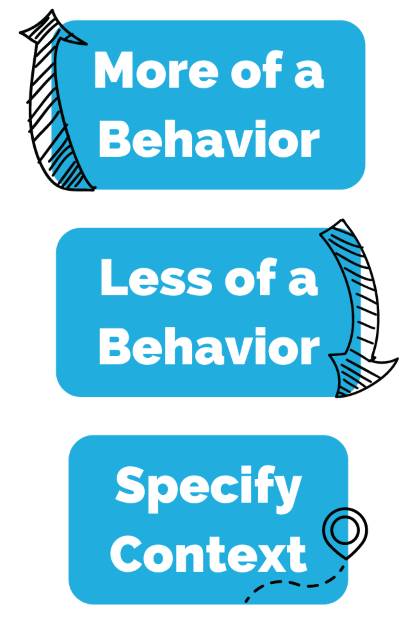Applied Behavior Analysis (ABA) in Schools: Understanding the Fundamentals to Effectively Use ABA

This article originally appeared in START Connecting in December 2022
If you work in schools, you have likely used practices from Applied Behavior Analysis (ABA), even if you did not know it. This includes a wide range of practices such as: using high frequency opportunities to respond when teaching a lesson, providing practice with specific feedback, conducting progress monitoring in a reading intervention to guide next steps, using a prompt hierarchy, and teaching communication using the Picture Exchange Communication System (PECS). Even functional behavior assessment, an IDEA mandate, is derived from ABA.
Fundamentally, evidence-based instruction and behavior support have a basis in ABA. (See the Umbrella of Practices for a list of behavioral principles and practices.) If you are wondering about practices you may be using, check out the Do I use principles and practices from ABA? quiz.
What is ABA?
The technical definition: The process of systematically applying interventions based upon the principles of learning theory to improve socially significant behaviors to a meaningful degree and to demonstrate that the interventions employed are responsible for the improvement in behavior.
A layperson explanation: There is a science called ABA with evidence-based principles and practices that may be used to have a meaningful impact on socially significant behaviors that leads to new skills and improves quality of life. Using behavior analysis involves systematically planning and delivering interventions while collecting and visually analyzing data to make decisions about the effectiveness of the interventions being implemented.
The words in this explanation look quite relevant to schools – evidence-based, meaningful impact, socially significant behaviors, systematic planning, delivering intervention, making decisions based on data. It’s almost as if ABA was designed to be used in schools. In fact, the application of behavior analysis to education and learning was important to its early developers.

What do we mean by behavior change in ABA?
ABA is about behavior change to benefit the individual and even the larger community. ABA may be used to teach a student to functionally communicate or follow a self-management plan. At a classroom level, a group contingency may be used to help students stay focused during group instruction, resulting in more instructional time. At a school-level, ABA practices may be used to teach safety skills to students and staff that benefit the entire school community. At a societal level, ABA may be used to increase the use of seatbelts or reduce littering. In each of these examples, there is a behavior targeted for change.
If you think of any instance of behavior change, you can put it into one of these categories - 1) we want more of a behavior, 2) less of a behavior, or 3) to specify the context. Within these categories, we have six ways of targeting a behavior to support learning and positive outcomes: increasing behavior, teaching new skills, maintaining behavior, reducing behavior, narrowing the conditions of the behavior, and generalizing behavior.
Take a look at a case example to see how this could be used by a teacher working with a third grade student. A similar approach may be used with students across grade-levels.

|
More of a Behavior |
Less of a Behavior |
Specify Context |
|---|---|---|
|
Increase behaviors (e.g., on-task behavior, number of social interactions) |
Reduce or eliminate interfering behaviors (e.g., wandering, yelling, aggression) |
Narrow conditions of behavior (e.g., when and where a behavior happens) |
|
Teach new skills (e.g., communication skills, following a routine, reading) |
Generalize behavior (e.g., setting, people, materials) |
|
|
Maintain behaviors (e.g., asking for help, self-monitoring) |
Four ways we can strengthen the use of ABA principles and practices in schools
- Use the principles and practices of ABA with intentionality. This means learning about ABA principles and practices, knowing how to use them effectively, and systematically planning for their use.
- Use the practices with fidelity. Implementing with fidelity means following the specifications of the practice step by step. The best way to do this is with a fidelity checklist, which is simply a breakdown of the steps put into a checklist. Think of this like a recipe that requires accurate completion at each step if you want the best outcome.
- Collect and use data for decision making. Any plan for teaching or intervention needs to have a plan for data collection that includes visually reviewing the data (preferably a graph), evaluating whether the plan is working, and making adjustments based on data.
- Effectively integrate ABA practices with other effective approaches in schools, such as relationship building, trauma-informed practice, effective pedagogy, and ancillary support services (e.g., OT, PT, speech).
We encourage you to learn more about ABA in schools by reviewing a short course developed by the authors of this article to teach school staff and administrators about ABA in schools. This free course is offered through Michigan Virtual University with 2 SCECHs available. In this course, you will also learn how Positive Behavioral Interventions and Supports (PBIS) is integrally connected to ABA.
Resources
- ABA in Schools – free, Michigan Virtual University short course
- ABA Fact Sheet - Family Matters by Michigan Alliance for Families and MDE, OSE
- ABA in Schools quiz (Google slides) - watch in slideshow mode
- ABA in Schools quiz (pdf) - download to use the interactive responding
- ABA in Schools Case example
Additional Information
ABA as an insurance-funded service for autism is based on the same principles and practices described above, but is set up in a different delivery system with oversight by Board Certified Behavior Analysts. For more information, see the resource provided by the Council for Autism Service Providers and the Family Matters Autism Insurance, Medicaid, and Education Fact Sheet.
By Amy Matthews, Ph.D., BCBA (Project Director) and Stephanie Dyer, Ed.S., BCBA (Autism Education and Intervention Specialist)
